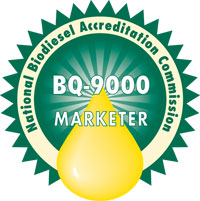 The biodiesel industry is growing, thanks in part to cities using the cleaner-burning fuel for diesel engines because it’s better for the environment. And no city in the nation knows that better than San Francisco. San Francisco uses the most biodiesel of any city – in its buses, utility vehicles, and more – and retail pumps sell it to motorists as well.
The biodiesel industry is growing, thanks in part to cities using the cleaner-burning fuel for diesel engines because it’s better for the environment. And no city in the nation knows that better than San Francisco. San Francisco uses the most biodiesel of any city – in its buses, utility vehicles, and more – and retail pumps sell it to motorists as well.
Spot a city bus, a fire truck, or a double-decker tour bus in San Francisco, and chances are pretty good that it is running on 20 percent biodiesel (B20). The area’s biodiesel enthusiasm even flows beyond the “City by the Bay” into the Bay itself, where the famous Red and White Ferries cruise on B20.
“San Francisco is an inspiration to our industry like none I’ve ever seen,” said Joe Jobe, CEO of the National Biodiesel Board. “The enthusiasm for biodiesel is in every corner of the city. The commitment is contagious, and I am eager for our conference attendees to experience it for themselves.”
The San Francisco City Government is the largest known city in the world to use B20 fleet-wide, one of many reasons it is the perfect host for the 2009 National Biodiesel Conference & Expo, Feb. 1–4.
The conference educational program will be kicked off by the people who have made the biodiesel program there a success. Mayor Gavin Newsom is anticipated to speak. In 2006, he issued an Executive Directive designed to increase the pace of municipal use of biodiesel. Today, virtually all of the City’s 1,500 diesel vehicles run on B20. The City uses about five million gallons of B20 a year.
Other speakers from the City will include Marty Mellera, chief of Climate Action and Greening. Vandana Bali, clean vehicles manager at the Department of the Environment, Mike Ferry of the San Francisco Fire Department and past recipient of the Eye on Biodiesel Inspiration Award, and Karri Ving, biofuels coordinator for the Public Utilities Commission.
Each year the annual National Biodiesel Conference offers valuable educational and networking opportunities. This year, one new feature is sustainability sessions supplementing existing educational tracks. For more information and to register, please visit: www.biodieselconference.org .
New Biodiesel Quality Specs Announced
Other recent news that will put biodiesel more in the public eye as well is the addition of new specifications for biodiesel. These specification updates will help lead to greater biodiesel blend uses for consumers. Biodiesel blends refer to biodiesel and regular diesel fuel blended together and is denoted by a “B” in front of a number. For example, B20 refers to 20 percent biodiesel and 80 percent diesel fuel.
Biodiesel is reaching new heights as a proven fuel, bolstered by new quality specifications for biodiesel blends published by ASTM International. Biodiesel producers, petroleum companies, engine companies, vehicle manufacturers, pipeline operators, fleets and consumers will benefit from the new biodiesel blend specifications, using them for fuel preparation, quality checking, engine design, and bid and purchasing contracts. Key National Biodiesel Board personnel have worked the past few years to make this a reality.
ASTM International, one of the largest and most highly regarded standards development organizations in the world, recently officially published the highly-anticipated biodiesel blend specifications on the ASTM web site, www.astm.org, for general use.
Steve Howell, technical director for the NBB and chairman of the ASTM Biodiesel Task Force, has been NBB’s liaison in this process and responsible for much of the work needed by ASTM to adopt biodiesel specifications since the fuel’s inception. He noted that the specifications are set on a performance basis for a diesel engine, not on the feedstock or the production process. “These specifications combine the input of engine interests, petroleum interests, and biodiesel interests, as well as government and military representatives, researchers and academics. It took cooperation and a lot of data- and information-sharing between all those parties to reach consensus. This is an important achievement for the biodiesel industry that will help move us forward.”
Bob McCormick, principal engineer on Fuels Performance at the National Renewable Energy Laboratory (NREL) said, “The new ASTM standards for biodiesel blends are the result of years of negotiation between the various parties at ASTM and years of research on how the properties of biodiesel blends affect engine performance. NREL has conducted extensive research over the past four years to support development of these standards, which we believe will lead to an expansion of markets for biodiesel while at the same time ensuring that users have trouble-free performance.” This research was jointly supported by the U.S. Department of Energy and the National Biodiesel Board (NBB) under a Cooperative Research and Development Agreement.
![]() The new biodiesel blend specifications include ASTM D975-08a, Specification for Diesel Fuel Oils, revised to include requirements for up to 5 percent biodiesel; ASTM D396-08b, Specification for Fuel Oils for home heating and boiler applications, revised to include requirements for up to 5 percent biodiesel; and ASTM D7467-08, Specification for Diesel Fuel Oil, Biodiesel Blend (B6 to 20), a completely new specification that covers finished fuel blends of between 6 (B6) and 20 (B20).
The new biodiesel blend specifications include ASTM D975-08a, Specification for Diesel Fuel Oils, revised to include requirements for up to 5 percent biodiesel; ASTM D396-08b, Specification for Fuel Oils for home heating and boiler applications, revised to include requirements for up to 5 percent biodiesel; and ASTM D7467-08, Specification for Diesel Fuel Oil, Biodiesel Blend (B6 to 20), a completely new specification that covers finished fuel blends of between 6 (B6) and 20 (B20).
ASTM International also approved some updates to the existing ASTM standard for biodiesel, ASTM D6751, which is designed to control pure biodiesel (B100) product quality prior to blending with conventional diesel fuel.
The official publication of the new biodiesel blend specifications is welcome news to automakers and engine manufacturers, who have been requesting a finished blend specification for B20 biodiesel blends for several years. Some companies, such as Chrysler LLC, had stated that the need for that spec was the single greatest hurdle preventing their full-scale acceptance of B20 use in their diesel vehicles. Chrysler was instrumental in working with the ASTM task force toward B20 specification development and approval, having supported fleet use of B20 in its Dodge Ram diesel pickups since January 2006.
Biodiesel producers are also cognizant of the many benefits the new biodiesel blend standards hold for the industry. Joan McKinney of FutureFuel Chemical Company said, “FutureFuel expects the increased support of key stakeholders, such as engine and vehicle manufacturers and fuel refiners, resulting from the new blend standards to generate continued robust growth in our biodiesel sales.”
FutureFuel Chemical Company is one of the 34 companies currently certified as a BQ-9000 accredited biodiesel producer. The biodiesel industry’s BQ-9000 program couples the foundations of universally-accepted quality management systems with the ASTM product specifications, and has become the premier quality designation in the industry. BQ-9000 also certifies marketers of biodiesel; there are 15 marketers certified thus far under the program.
The ASTM International biodiesel standards can be purchased from ASTM Customer Service service@astm.org or at www.astm.org.
Biodiesel Industry Overview of Growth and Benefits
Advancements and educational events such as these have lent to the growth of biodiesel. In 2004, there were 25 million gallons of pure biodiesel produced in the U.S.; in 2005: 75 million gallons; in 2006: 250 million gallons and in 2007: 500 million gallons. It is anticipated that 2008’s production will easily surpass 2007 production. In 2009, the biomass-based diesel component of the federal Renewable Fuel Standard will ensure that at least 500 million gallons of biodiesel be produced and used within the United States.
There are currently 176 commercial biodiesel plants operating in the U.S., with dozens in development. There are approximately 1,200 retail pumps selling biodiesel blends or pure biodiesel and 1,900 distributors supplying biodiesel to retailers or centrally-fueled fleets. Bioheat ® fuel, a blend of biodiesel and home heating oil for homes typically in the Northeast who use Oil heat, is also gaining ground.
Biodiesel works in existing diesel vehicles without modification – from all diesel cars such as Volkswagens, up to tractor trailers. Biodiesel reduces life cycle CO2 by 78 percent and cuts most EPA regulated emissions by 50 percent in its pure form. It has one of the highest energy balances of a liquid fuel – for every unit of energy it takes to make biodiesel, 3.5 units are gained. Biodiesel can be made from any plant oil or animal fat, or recycled cooking oils. There is increased emphasis on future arid-land feed stocks such as algae.
Take a Closer Look at the NBB
The National Biodiesel Board is the national trade association for the biodiesel industry, coordinating research and development and providing the largest clearinghouse of biodiesel information. Public access to this information is available on www.biodiesel.org .


